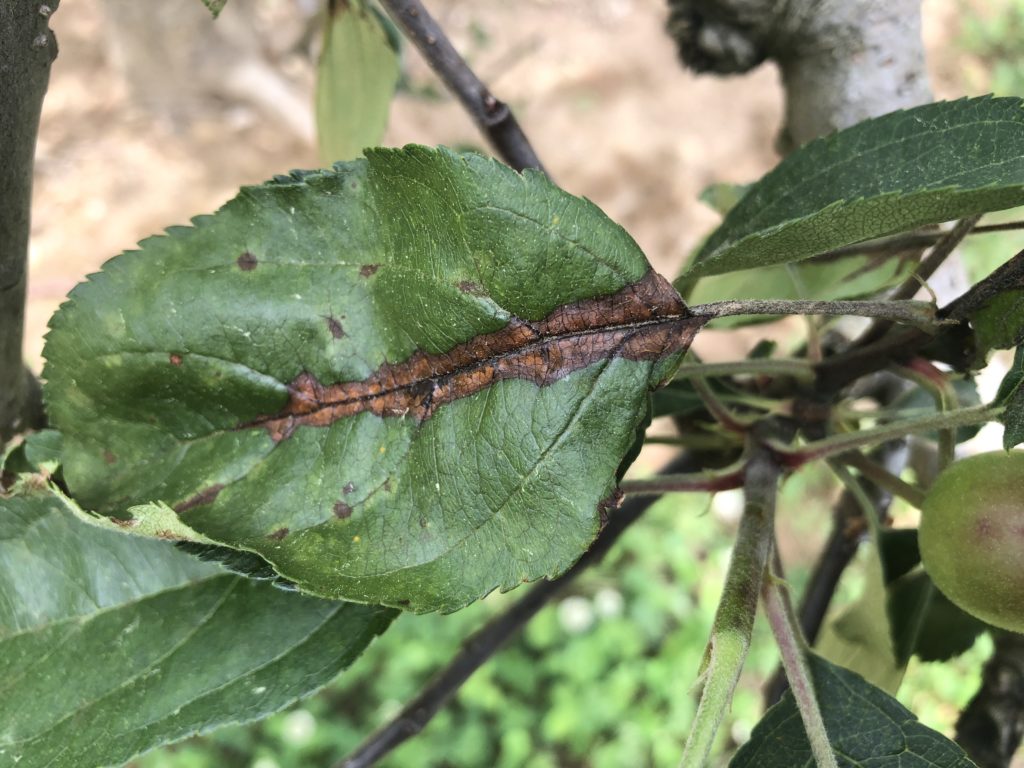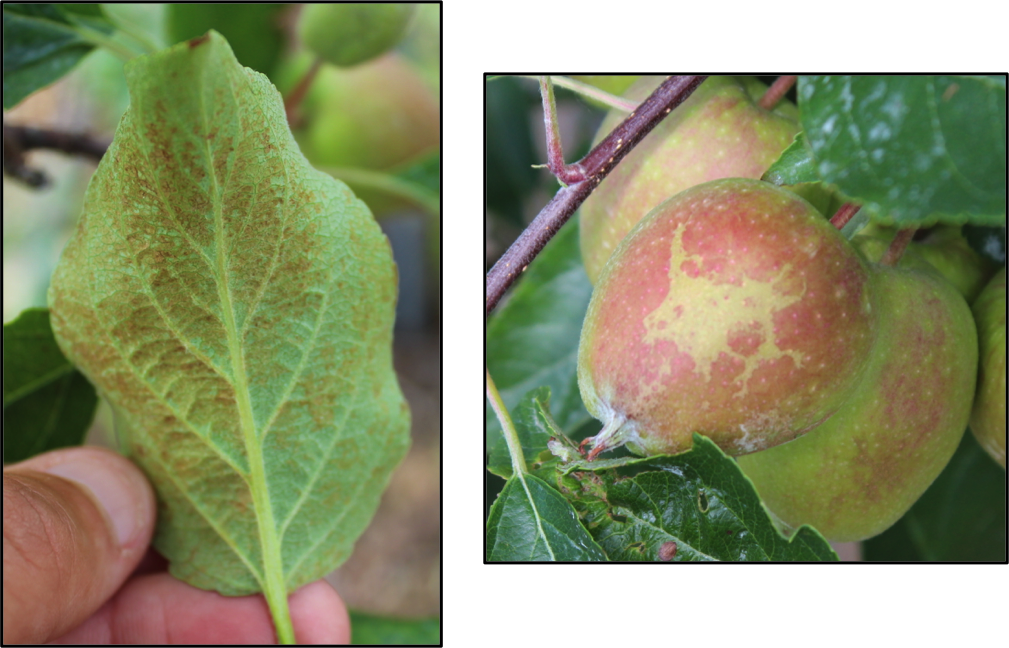Apple Disease Update: 3rd and 4th Cover
go.ncsu.edu/readext?529102
en Español / em Português
El inglés es el idioma de control de esta página. En la medida en que haya algún conflicto entre la traducción al inglés y la traducción, el inglés prevalece.
Al hacer clic en el enlace de traducción se activa un servicio de traducción gratuito para convertir la página al español. Al igual que con cualquier traducción por Internet, la conversión no es sensible al contexto y puede que no traduzca el texto en su significado original. NC State Extension no garantiza la exactitud del texto traducido. Por favor, tenga en cuenta que algunas aplicaciones y/o servicios pueden no funcionar como se espera cuando se traducen.
Português
Inglês é o idioma de controle desta página. Na medida que haja algum conflito entre o texto original em Inglês e a tradução, o Inglês prevalece.
Ao clicar no link de tradução, um serviço gratuito de tradução será ativado para converter a página para o Português. Como em qualquer tradução pela internet, a conversão não é sensivel ao contexto e pode não ocorrer a tradução para o significado orginal. O serviço de Extensão da Carolina do Norte (NC State Extension) não garante a exatidão do texto traduzido. Por favor, observe que algumas funções ou serviços podem não funcionar como esperado após a tradução.
English
English is the controlling language of this page. To the extent there is any conflict between the English text and the translation, English controls.
Clicking on the translation link activates a free translation service to convert the page to Spanish. As with any Internet translation, the conversion is not context-sensitive and may not translate the text to its original meaning. NC State Extension does not guarantee the accuracy of the translated text. Please note that some applications and/or services may not function as expected when translated.
Collapse ▲ Yesterday I posted an Apple Alert: Rain Addition, which focused on how to approach applying fungicides during extremely wet weather. Just to recap:
Yesterday I posted an Apple Alert: Rain Addition, which focused on how to approach applying fungicides during extremely wet weather. Just to recap:
- Locally systemic/single-site fungicides (e.g., Flint, Inspire Super, Merivon, Aprovia): IF these products are able to completely dry and be absorbed by plant tissue prior to a rain event, then their residual activity will likely be longer than protectant fungicide.
- Spraying captan, mancozeb, and ziram during a light rain is better than not spraying at all. In some cases, the rain can even help in redistributing the fungicide. You’ll likely have to apply fungicides more than normal during this period.
- Assume that trees are no longer protected after 2 inches of rain.
- Have your cell phone in case your tractor gets stuck
I’ve had some discussions today on weather a spreader/sticker should be applied with captan while spraying during light rain or prior to a heavy rain event. While a spreader sticker may potentially result in less captan being lost to rainfall, the risk of phytotoxicity may increase. Captan labels clearly warn against:
- Applications under slow drying conditions
- Applications following rainy, humid, windless weather where young fruit and leaves don’t have a well developed cuticle (usually of greatest concern up until 2nd/3rd cover)
- Applications with surfactants and spreader stickers that may disrupt the waxy cuticle.
- While on this topic, although the label does not state it, there calcium chloride in tank mixture with captan also can cause russeting to fruit.
Glomerella Leaf Spot and Bitter Rot: Most growers in Western NC are likely on their 3rd or 4th cover (or later cover?) application. We are reaching what I like to refer to as the “Glomerella maintenance period”. This means……
- Tighten up spray intervals. 50% of captan residues can be depleted in 1/25 inches of rain. 2 inches of rain and figure they are completely depleted. We are not sure what the heavy dew does in terms of captan residue depletion, but my thought is better safe than sorry until we can answer the dew question.
- In research trials at MHCREC, Captan 80WDG 3.75 lbs + ProPhyt 4 pts during later covers (2nd cover to last two sprays before harvest) was highly effective against GLS/bitter rot, when applied on a 7 to 10-day interval. Ziram 3-4 lb + Captan 80 WDG 2.5 lbs was also effective. Although we did not test it directly, a rotation of Ziram 4 lb + ProPhyt 4 pt with Captan 3.75 lb + ProPhyt 4 pt is likely to provide as high of levels of efficacy.
- Mancozeb is highly effective against GLS and bitter rot. While you may have reached the 77 day PHI with early harvest cultivars like Gala, consider keeping it in the tank with later susceptible cultivars such as Pink Lady.
- If you haven’t applied 2 stroby’s (FRAC 11) yet, do so tank mixed with a protectant. I suggest keeping two applications of a stroby containing fungicide (either Merivon or Pristine) until right near harvest.
Shoot Blight: The photo up top shows a leaf with mid-vein necrosis that developed after a shoot blight infection. Conditions continue to be ideal for shoot blight. If you have not applied two applications of prohexadione calcium for shoot blight management, there is still time to do so. For mature trees, apply Kudos or Apogee at a rate of 6-12 oz/100 gal and for young trees (5 years or younger) 3 to 6 oz/100 gal. If shoots were infected during last week’s rain, an application of prohexadione calcium may slow down the infection, giving you more time to remove infected branches.
Apple Scab: In yesterday’s Apple Alert I indicated that there have been reports of apple scab throughout Henderson County (including my research orchard). Even a few primary infections can lead to an epidemic of apple scab due to secondary infections. If there is any concern that a primary scab infection wasn’t protected, I’d suggest applying Aprovia (7 fl oz/A). Aprovia provides about 50-60% control of GLS/bitter rot, so do not use this as your only fungicide in the tank this week. 
* These are the big three for the week. Flyspeck/Sooty Blotch infections are also predicted throughout much of North Carolina. Captan + ProPhyt are fairly effective, but you may want to consider adding a “helper” single site/locally systemic fungicide into the mix if you’ve had issues with the disease in the past. Inspire Super and Aprovia have both been very effective for us in research trials.



